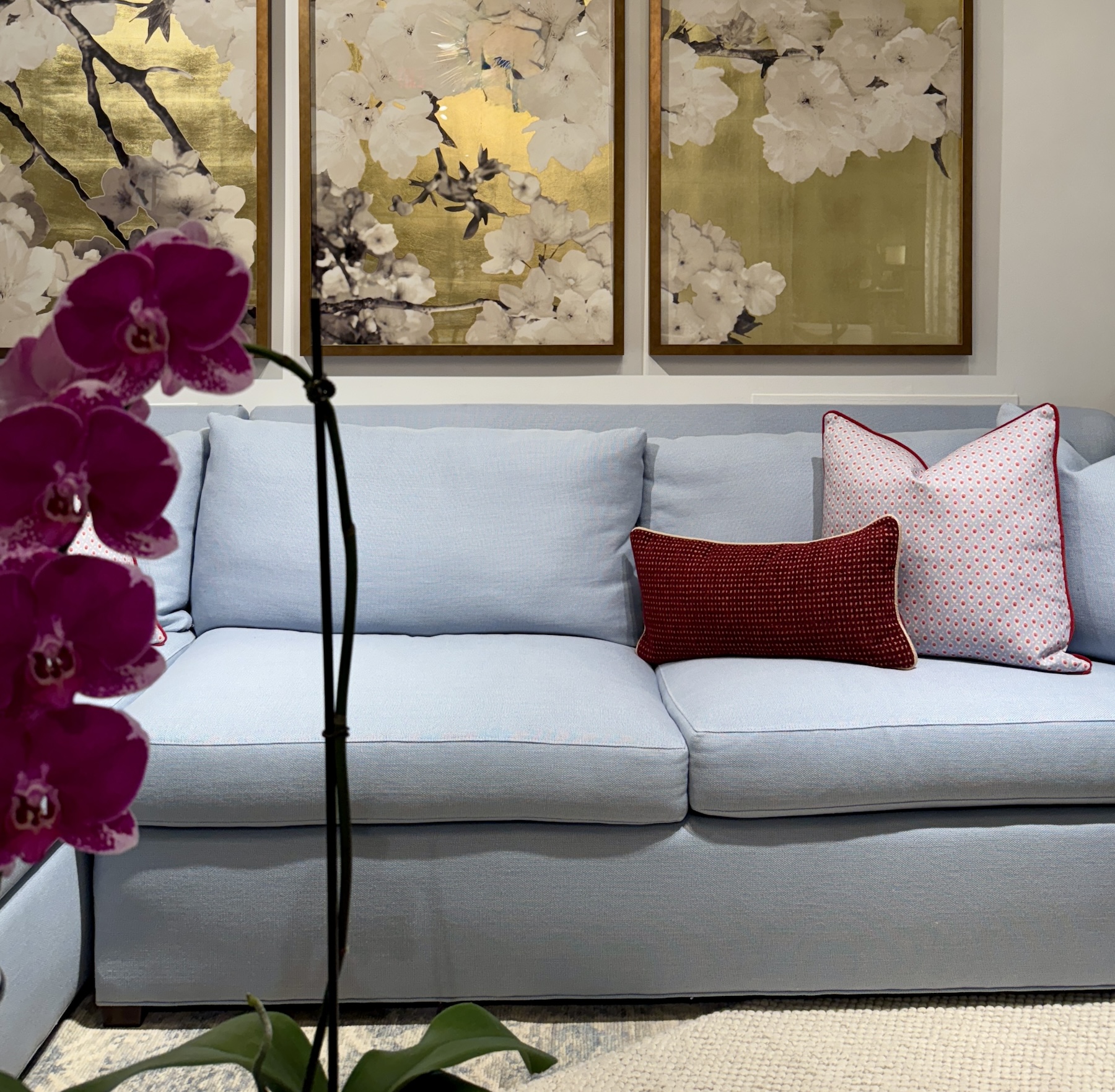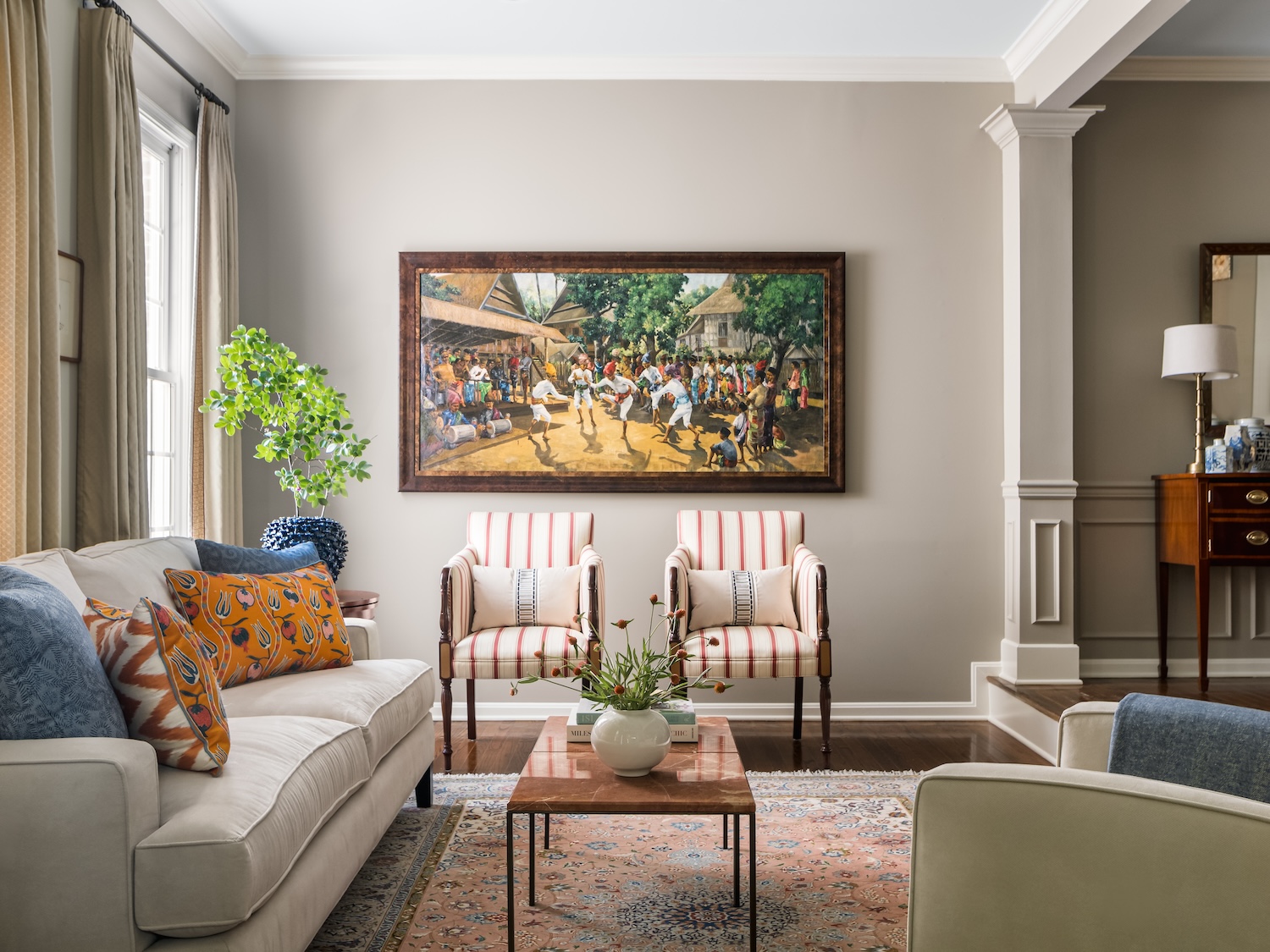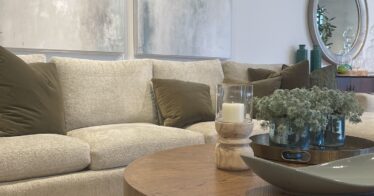Beyond beautiful furnishings lies the real value of professional design: expert vision, trade access, and the experience to create cohesive spaces that enhance your life.
The recent Aaron Judge vs. Drew Designs LLC interior design lawsuit has brought forward important questions regarding interior design billing practices and contracts for interior design services.
It has also sparked discussions about what clients should know before embarking on a luxury design journey.
As we explore what transparency means in luxury interior design, it’s important to understand our own approach at Pembrook Interiors and how it differs from other models in the industry.
The Aaron Judge Case: A Catalyst for Important Conversations
The recent lawsuit between New York Yankees star Aaron Judge and interior designer Mandy Drew (Drew Designs LLC) has sparked important conversations about transparency in design contracts. The case, filed in January 2025, involves allegations of hidden markups and lack of billing transparency in a luxury home design project.
While we cannot and will not comment on the specifics of this ongoing legal matter, such situations highlight why clear financial agreements are essential for both clients and designers.
Importantly, interior design firms are all different, meaning that each firm has a different aesthetic, specialty and service offering. These differences translate into countless different approaches to contracting and billing. Even if you’ve worked with design firms in the past, each firm is likely to approach the service offering and billing process differently.
Additionally, changing billing practices within a firm over time are also likely as specialties, focus areas, and the market evolve. Interior design is an industry that has changed dramatically in the last ten years.
At its core, Pembrook Interiors is a consulting firm with expertise in interior design and consumer products. We are also a retail “store” offering an array of custom and to-the-trade furnishings, textiles, lighting and accessories for the home and branded commercial spaces (e.g. vacation rentals, boutique hotels, executive offices, doctor’s offices).
We offer full-service interior design, which is a combination of design consulting, and the sale of the products and trade services required to fulfill and implement the design. Just as every project is different (i.e., different objectives, different starting points, different requirements to get from A to B), each project is contracted for and priced individually.
On request, we offer design services with a more limited scope. For instance, we offer custom draperies and window treatments (an example of a retail product) or space planning and lighting design (an example of a stand-alone design consulting service).
We view the Aaron Judge interior design case as an opportunity to educate clients about interior design billing practices and how to protect themselves when investing in professional design services. The lawsuit underscores the importance of understanding design firm contracting, interior design billing and project management practices.
It’s worth repeating, every design firm is different in terms of how their contract works, the services they provide, and how those services are priced and billed.
The Value Proposition of Professional Interior Design
Full-service interior design is more than selecting beautiful furnishings—it’s a comprehensive service that transforms your living environment while protecting your investment.
For Pembrook Interiors’, this “service” is comprised of two elements—the conceptual design itself, and procurement and implementation of the goods and services necessary to bring the design to fruition. It is not about shopping.
Before discussing contracts and interior design billing structures, it’s important to understand what truly exceptional interior design delivers:
- Expert Vision & Execution: Years of training and experience translate into cohesive designs and hard-earned insights that enhance both aesthetic appeal and functionality
- Technical Expertise: Professional knowledge of materials, construction methods, and performance characteristics ensures optimal functionality and longevity of the design and investment
- Trade Access: Connections to exceptional vendors and craftspeople unavailable to the public, and the knowledge to navigate this complex and ever-evolving landscape of home and consumer products
- Project Management: Coordination of complex timelines, vendors, and installation logistics
- Problem Prevention: Foreseeing potential issues before they become costly mistakes (e.g., we know where to put the floor outlet long before the furniture is even ordered, how low your dining room chandelier needs to be before the wires are cut!)
- Long-Term Value: Creating timeless designs that enhance the function, aesthetic beauty, and adaptability of a home
Common Interior Design Billing Models
There is no universal model for interior design billing. Generally, an interior firm will adopt a billing model that supports the firm’s business model.
Like business models, the billing model is likely to change over time, as the market evolves, or consumer preferences change. For instance, changes in the long-haul transportation industry (what we refer to in house as the “Amazon-effect,”) altered our pricing model.
Experience has also shown us that most clients now prefer streamlined billing and flat design fees that translates into greater interior design investment certainty.
Regardless of the billing model used, the billing model should be specified in the interior design contract for your project.
There are a variety of compensation models in interior design. Understanding the common different compensation models helps clients make informed decisions about the services they’re receiving.
1. Flat Fee Design Services
This approach involves a predetermined fee for the design phase, typically calculated based on square footage or project’s scope of work. This is often the most straightforward method as clients know exactly what they’re paying for design services upfront.
Generally, design services do not include goods or trade services (such as the installation of the goods).
2. Hourly Rate Structure
Some designers bill by the hour for all work performed. While appropriate for smaller projects or consultations, this model can create uncertainty about final costs for larger projects.
Hourly rates can be the firm’s hourly rate, or combinations of individual employee hourly rates. Hourly rates may vary for and apply to travel, and per diems for meals and travel expenses are often additional when those fees apply.
3. Cost-Plus Model
Designers purchase furnishings and materials at “trade pricing” and add a markup percentage. This percentage compensates the design firm for time and expertise in the procurement and management of the goods and trade services required for the implementation of the design project.
The markup typically ranges from 20-60% and should be clearly disclosed upfront.
Note that not all designers have access to trade pricing and the financial conditions for the designers’ access to trade pricing will vary among designers, and even from year-to-year or season-to-season for the same vendor.
Additionally, access to different trade pricing levels will vary based on the design firm’s volume with a particular vendor, status as a stocking dealer, and decisions to invest in sample subscription programs just to name a few.
Finally, it would not be uncommon for a designer to need to access a particular component for a design project at retail pricing. A common example of a design project component that the designer may source at “retail” might be an electrical power strip, or perhaps even design elements sourced at auction.
The key point here is that “trade pricing” is not the same for every design firm, or for every resource that the design firm accesses. Determining which trade resources to access is actually a strategic decision for a design firm, and one that Pembrook Interiors invests countless hours in annually.
4. Percentage-Based Fee
Some designers charge a percentage of the total project cost, which can range from 15-30% or more depending on project complexity and scope.
This billing approach is likely common among interior design firms that are managing and overseeing the interior finish and material selections for a remodel or new build, or in instances where, for example, the total project cost is pre-determined by another entity such as a contractor or builder.
This approach is also common for complex, large scale, high investment commitment projects, and a particularly useful billing approach if, for example, the designer is accompanying the client on unique sourcing expeditions, like let’s say a European antique hunt, or advising on fine art commissions or purchases.
5. Hybrid Models
Many firms, including Pembrook Interiors, use a combination of these approaches—often a flat design fee plus retail cost for goods and percentage-based trade services management for the associated procurement and management of those trade services used for the implementation of the design.
Note that the design phase of an interior design project would not typically include the “goods” or trade services (e.g. wallcovering and installation). However, the design phase will often include important deliverables.
Common design phase deliverables are a project “mood board,” a scaled floorplan, renderings (i.e., conceptual drawings of the finished space), textile and hard surface plans, and color schemes. The design phase deliverables are those documents and visuals that are used to create and ensure aesthetic alignment for the project between the designer and the client.
In other words, the design phase deliverables are how we know that we (as designers) are on the same page with the client in terms of how the finished space will look, before demo or sourcing begins.
Since we include an estimated Implementation Investment in our Letter Agreement, Pembrook Interiors includes a line-item budget review for the design project among the design phase deliverables of our full-service projects.
Estimating the Implementation Investment (Goods, Trade Services and the Trade Services Management Fee) upfront in the Letter Agreement is how we make sure everyone is on the same page regarding the anticipated total project investment.
In contrast to the Implementation Investment established in the Letter Agreement as an estimate, the Design Investment (aka the design consulting piece) is fixed in the Letter Agreement.
The Pembrook Interiors Approach: Clarity from Day One
Our letter agreements are structured to prevent misunderstandings and ensure clients always know exactly what they’re paying for. Our letter agreement lists the Design Investment, which is a fixed fee based on the project’s complexity, and an estimated Implementation Investment.
The Implementation Investment includes the retail cost of goods, and trade service plus a trade services management fee that is a percentage of the actual trade services cost. Transportation is a regional flat percentage fee applied to the retail cost of goods. The on-site installation crew is a trade service.
In the final project invoice, due 2-4 weeks prior to project completion, the estimated Implementation Investment is trued-up to actual. We estimate the Implementation Investment because of uncertainty in product costs and availability over the lifespan of a project, as interior design projects typically require a minimum of six months to complete, largely due to the lead time for custom elements.
For an optional fee, Pembrook Interiors will “lock-in” the Implementation Investment at the time of contracting. This financial certainty is most useful in commercial projects where we are working with a team of investors, for example.
Residential projects benefit from the estimated implementation investment approach because the estimate serves as the project’s budget but allows us to show a wider range of item selections for the project (such as better and best). In other words, using an estimated Implementation Investment allows us to offer selection options, options that we often discover during sourcing as new products are introduced.
Design Investment
We use a flat fee structure for our design services based on the scope of work outlined in our Letter of Agreement. As stated in our contract: “This fee covers the design development phase of your project, culminating with the Design Concept Presentation.”
The design fee compensates us for our expertise, creativity, and time invested in creating your custom design plan. It is separate from the cost of goods and trade services and the associated management fees.
Project Investment Structure
When the project moves from the Design Phase to the Implementation Phase, 80% of the estimated Implementation Investment is due. The detailed estimated Implementation Investment is based on our experience with similar projects.
For the implementation phase, we invoice the retail cost for goods (plus flat rate transportation) and trade services plus the trade services management fee (including on-site installation) by line-item.
The final invoice adjusts the estimated Implementation Investment to the actual Implementation Investment. As trade resources and pricing arrangements are proprietary and our sourcing strategies are confidential, vendor details are redacted from receipts.
We provide receipts on request but retain electronic copies as a part of your design project file for our records.
Smart Investment Planning
As outlined in our article Interior Design Investment: A Strategic Guide to Project Success, our full-service design projects include comprehensive design investment planning that is reviewed as part of the Design Concept Presentation. Our suggestions for investment planning include:
- Setting aside 10-15% of your total anticipated investment for contingencies
- Understanding the long-term value of quality design elements (15-20 years or more)
- Recognizing that quality pieces are portable assets that can enhance multiple homes
- Avoiding common pitfalls like focusing solely on one area (such as a kitchen) while neglecting the holistic design
Red Flags in Design Contracts
When reviewing any interior design contract, be wary of:
- Vague fee structures without clear delineation between design services and procurement
- Failure to disclose the designer’s compensation method
- Absence of detailed estimates before major purchasing begins
- No clear process for change orders or budget adjustments
- Limited documentation of charges to the client
- No provisions for return policies or what happens if items don’t work in the space (Note that most goods sold by interior designers are final sale, as many items are special order and custom. Goods that are not final sale or presented for consideration are typically offered “on approval.”)
Questions Every Client Should Ask Their Designer
To ensure transparency in any design relationship and avoid surprise bills, consider asking:
- How exactly is your fee structured? What specifically does it cover?
Our answer: We use a two-part fee structure that consists of a design fee and an implementation investment. We charge retail for goods and trade services are billed at actual plus the percentage-based trade services management fee. Transportation is a flat-rate percentage based on the retail cost of goods and the on-site installation crew is a trade service. - Do you markup furnishings and contractor services? If so, by what percentage?
Our answer: We do. We charge retail for goods. A management fee is added to the cost of trade services and compensates our firm for sourcing and scheduling trade services and overseeing implementation just to name a few. - Will I receive copies of original vendor invoices and documentation?
Our answer: No. We are a retail “store.” How we source goods, and our vendor pricing is confidential and a trade secret. This is akin to going to a great restaurant, enjoying an expertly prepared meal and then asking to see the precise cost breakdown of every ingredient, the per meal allocation of the place-setting cost, and the atmosphere. We do retain trade service invoicing and will provide those on request. - How are change orders handled and documented?
Our answer: We will discuss the desired change and the associated costs and document it with a change order that will be an addendum to the project contract. - What is your policy on refunds for items I decide not to keep?
Our answer: We exercise great care in the selection and sourcing of items for your project. Most items are custom and are not refundable. If we make a mistake and the item doesn’t fit, we make it right at our expense. We guarantee the goods and trade services you get from us for 2 years (see our FAQ for details on restrictions). We do offer this assurance because we are confident in the goods and trade services we offer to our clients. - What contingencies should I plan for in my budget?
Our answer: We build contingencies into our Implementation Investment estimates so that you don’t have to. If you are not working with us, please see our article on Interior Design Investment Planning. You should set aside a contingency fund because things always happen. Additionally, most DIY project budgets erode well before completion because of the allure of upgrades. - How do you handle project delays or unexpected issues?
Our answer: We will notify you promptly. Our clients receive a written project status report weekly or biweekly. This keeps the project details fresh and at your fingertips. Additionally, we are always available by phone if something arises. During project work on site, we are in regular contact with the trade services, and are often on-site with them. - What happens if we need to pause or terminate the project?
Our answer: Our contract includes a project pause clause and a project termination clause.
Our Commitment to Documentation and Transparency
At Pembrook Interiors, every project includes:
- Comprehensive scope of work with detailed deliverables by room
- Clear fee structure with payment schedules
- Explicit procurement management procedures
- Transparent documentation of all costs
- Formal change order processes
- Weekly project updates and status reports on all orders
Understanding the Long-Term Value of Interior Design
Unlike many home improvements that are fixed in place, quality interior design investments can appreciate, negate the need for extensive home sale “staging,” and provide the flexibility to move with you. This portable value proposition makes interior design a unique investment in both current and future living spaces.
When developing interior design strategies for our clients, Pembrook Interiors considers:
- Your intended length of stay in your current home
- The portability of design elements
- Future adaptability of key pieces
- Quality levels that ensure longevity
- Potential for pieces to be reimagined in new spaces
The best interior design investment is not actually the kitchen or bathroom, as common wisdom suggests. Instead, it is actually the investment you can take with you and enjoy for decades.
Partnership Built on Trust
The designer-client relationship should be built on mutual respect, clear communication, and complete transparency. At Pembrook Interiors, we believe that financial clarity is the foundation of a successful design relationship—a principle that stands in stark contrast to the allegations in the Aaron Judge interior design case.
When you engage Pembrook Interiors, you’re not just hiring a service provider—you’re partnering with dedicated professionals who will guide you through the complex process of creating a space that enhances your life and reflects your personal aesthetic, with no hidden fees or surprises.
We welcome questions about our business practices and are committed to setting the industry standard for transparent, ethical business practices in luxury interior design.
For more information or to schedule a consultation, please contact Jennifer Fordham, CEO and Principal Interior Designer at Pembrook Interiors: 703-336-2886.









